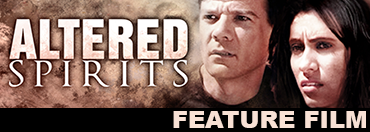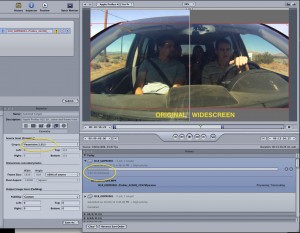Post production photo: GoPro Car-Cam
You’ve probably seen the TV commercials for the GoPro Hero HD camera, the tiny camcorder popular with skydivers, hang gliders, surfers and race car drivers to get those incredible action shots.
Broken Spirits director Peter Bohush has owned his GoPro for several years now, and put it to use for some special shots in the movie. Check out the shot in the Trailer #1 where Trey (Gregory Crafts) nearly stomps on the camera as he’s being chased by the evil Indio (Peter Jang.) Or the behind-the-scenes video of Scott (Steve Weese) falling off a small cliff and crashing into the camera, and Cookson (Dave Pereyra) running through the creek and splashing over the camera. These were all shot on our little GoPro.
Here’s a screenshot from our post-production workflow showing the longest shot of the whole movie, shot with Peter’s GoPro suction cupped to the hood of an SUV as Trey, Daniel, Scott and Valerie drive toward the sweat lodge at the opening of the movie. When the camera rolls on a feature film, usually it records somewhere between 45 seconds to 3 minutes for a single “take.” The longer times are when the director asks the actors to repeat the scene without stopping the camera and “re-slating.”
The driving scene pictured here is about a 3-minute scene by itself. But the way we captured it was to turn the camera on once it was suctioned to the car hood, roll the audio recorder hidden inside the car, and let the actors drive off into the desert and run their lines. By the time they came back to base camp the camera had been rolling for more than 21 minutes!
Since there are several good “takes” from which to choose, we kept about the first 14 minutes of footage. Here’s where the “fun” part comes in.
The GoPro records at a “television” frame rate of 30 frames per second. This is the same as most consumer camcorders and even your iPhone’s video. But the rest of the movie was shot, and being edited, at the “film” rate of 24 frames per second. So we have to convert the GoPro video to 24 frames per second using software, in this case Apple’s Compressor application.
Additionally, we want to make sure there is no loss of data quality in the video, AND we need to change the size of the video from the height and width of an average TV screen or computer monitor to the “widescreen” aspect of motion pictures. You can see that in the screen shot. On the left half of the actors in the car is the original video size, and on the right what it will look like at widescreen. It makes for a more cinematic effect that matches the rest of the film, which was mostly shot on the RED MX digital cinema camera.
To run this 13 minute file through the conversion process will take nearly 7 hours! (See the circled “time remaining” number.)
But it’s all worth it to use this awesome shot of our four actors on their way to the mystical sweat lodge and their date with destiny.



